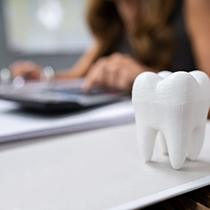Root Canal Therapy - Astoria, NY
Relieve Toothache Pain Today
 Root
canals have developed a bad reputation over the years. Most patients associate the need for root canal therapy
with pain and discomfort. If you’ve recently been informed you need a root canal, the ED Family Dental
team has good news for you – a root canal may actually relieve toothache pain! These restorative
treatments allow us to remove damaged tooth structure, and they can actually save teeth that would otherwise
need to be removed. If you need a root canal, take a deep breath. Then, give our Astoria dentistry team a call. We’ll schedule an appointment for you
to come in to see us as soon as possible, so you don’t have to deal with the pain and sensitivity that
proceeds these treatments for one second longer than you have to.
Root
canals have developed a bad reputation over the years. Most patients associate the need for root canal therapy
with pain and discomfort. If you’ve recently been informed you need a root canal, the ED Family Dental
team has good news for you – a root canal may actually relieve toothache pain! These restorative
treatments allow us to remove damaged tooth structure, and they can actually save teeth that would otherwise
need to be removed. If you need a root canal, take a deep breath. Then, give our Astoria dentistry team a call. We’ll schedule an appointment for you
to come in to see us as soon as possible, so you don’t have to deal with the pain and sensitivity that
proceeds these treatments for one second longer than you have to.
What is a Root Canal?
 A root canal is a
procedure that removes damaged tissue that has accessed the innermost layer of the tooth. Called pulp, this
interior layer is where the tooth’s nerve is housed. When decay or damaged parts of the tooth are able to
access the nerve, patients experience the tooth pain or sensitivity that gives root canals a bad name. By
removing and replacing this pulp and nerve tissue, we save the tooth and relieve toothache pain almost
immediately.
A root canal is a
procedure that removes damaged tissue that has accessed the innermost layer of the tooth. Called pulp, this
interior layer is where the tooth’s nerve is housed. When decay or damaged parts of the tooth are able to
access the nerve, patients experience the tooth pain or sensitivity that gives root canals a bad name. By
removing and replacing this pulp and nerve tissue, we save the tooth and relieve toothache pain almost
immediately.
How Will I Know I Need a Root Canal?
 The
only way to know for certain that you need a root canal is to visit our office for a consultation. We do see
many patients in need of a root canal on an emergency basis, so please call our office if you experience any of
the following warning signs:
The
only way to know for certain that you need a root canal is to visit our office for a consultation. We do see
many patients in need of a root canal on an emergency basis, so please call our office if you experience any of
the following warning signs:
- Severe toothache centered around an individual tooth
- Sensitivity to changes in temperature that lingers
- Darkening or discoloration of a single tooth
- Inflammation or infection in the soft tissue around a single tooth
How are Root Canals Performed?
 Root
canals are straightforward procedures. We begin by numbing the area around your damaged tooth to make sure
you’re completely comfortable. Then, we drill a small hole from the top of your tooth into the pulp. Next,
a series of files are used to remove the damaged tissues and any infection. In some cases, we need to complete
your root canal until after you’ve received a course of antibiotics. This reduces the risk of reinfection
or further damage. Once your tooth is free of infection and damaged tissue, we refill the pulp layer with a
biocompatible substance. We reseal the access hole, and typically, we recommend placing a dental crown to
protect the repaired tooth.
Root
canals are straightforward procedures. We begin by numbing the area around your damaged tooth to make sure
you’re completely comfortable. Then, we drill a small hole from the top of your tooth into the pulp. Next,
a series of files are used to remove the damaged tissues and any infection. In some cases, we need to complete
your root canal until after you’ve received a course of antibiotics. This reduces the risk of reinfection
or further damage. Once your tooth is free of infection and damaged tissue, we refill the pulp layer with a
biocompatible substance. We reseal the access hole, and typically, we recommend placing a dental crown to
protect the repaired tooth.
What Happens After Root Canal Therapy?
 Following root canal therapy, you will likely experience significant relief from the toothache and sensitivity
you experienced before we got started. You may experience some swelling or inflammation around the treated
tooth, but in a few days, you should be able to go right back to speaking, chewing, and smiling with complete
confidence thanks to your newly restored smile. If you have a ceramic or porcelain dental crown placed to
protect the treated tooth, make sure to use soft bristled toothbrushes and minimally abrasive toothpaste to
avoid excessive dental wear.
Following root canal therapy, you will likely experience significant relief from the toothache and sensitivity
you experienced before we got started. You may experience some swelling or inflammation around the treated
tooth, but in a few days, you should be able to go right back to speaking, chewing, and smiling with complete
confidence thanks to your newly restored smile. If you have a ceramic or porcelain dental crown placed to
protect the treated tooth, make sure to use soft bristled toothbrushes and minimally abrasive toothpaste to
avoid excessive dental wear.
Understanding the Cost of Root Canals

Do you need a root canal in Astoria? Before making any final decisions, you likely want to know how much it’ll cost. Well, it’s impossible to provide an accurate price estimate until you come in for an exam. Every patient is unique, and several factors must be taken into consideration. The only way to know for sure how much your treatment will cost is by scheduling a consultation with Dr. Shkurti. If you’d like a general idea of what to expect, continue reading or give our office a call today!
Factors That Can Affect Root Canal Cost

The exact cost of your root canal in Astoria is influenced by multiple factors, such as:
- The type and location of the tooth. Root canals for molars are usually more expensive than those for the front teeth because they have more roots.
- The overall complexity of the treatment. You may need to pay more than expected if a specialist needs to be brought in for a procedure.
- Any additional services that are needed. If you need additional treatment like a custom-made dental crown following your procedure, it can add to your overall treatment expenses.
Is it Cheaper to Pull My Tooth?

If you want to avoid getting a root canal, you may be thinking about going straight for extraction instead. While pulling a tooth has a lower initial cost, it’s important to take into consideration the long-term consequences of losing a natural tooth. For example, your bite could be negatively affected as the remaining teeth start to shift out of place. It can result in difficulty eating or general discomfort.
Many dentists recommend that you replace your missing tooth with a dental implant or bridge to prevent those issues. Of course, it’s worth noting that you’ll need to account for those additional costs. Ultimately, it’s more cost-effective to save your natural tooth than it is to pay for extraction and replace it later in life. Therefore, you should not avoid getting a root canal! The longer you wait, the more likely it is that the tooth will have to be extracted anyway.
Does Dental Insurance Cover Root Canals?

Since root canal therapy is considered a major procedure, it’s very common for dental insurance plans to cover anywhere between 50-80% of the cost after you have met your deductible. Of course, every policy is unique, which is why you should confirm the details of your coverage with an insurance provider before committing to anything. Our team is more than happy to help with that step if needed!
Other Options for Making Root Canal Therapy Affordable
We understand that not everyone has dental insurance. That’s why we offer an additional financing option to make your care as affordable as possible! We work with CareCredit, a third-party financier, to provide qualified patients with low-to-no interest payment plans. It allows you to split up the cost of your treatment into smaller, budget-friendly monthly installments.
Do you need to schedule a root canal in Lexington? Contact our office and make your appointment today! We’ll do everything we can to get your oral health back on track and keep your expenses as low as possible.
Root Canal FAQs

Are you still scared or worried about having to get a root canal? Facing the unknown can cause your thoughts to spiral and amp up your anxiety before your procedure. We’re here to set the facts straight so you know that you don’t have anything to fear. We’ve answered some common questions and concerns we get from our patients so you can be confident in your decision to save your natural tooth.
Why do I need a root canal?
Root canals are typically used to treat tooth infections. Without timely intervention, the issue could spread to surrounding teeth and impact other parts of your body, making it important to address the issue as soon as possible.
When a cavity goes left untreated, it can create a path of dental decay that leads to the innermost fragile portion of your tooth called the chamber. This is where the pulp that contains thousands of nerves hides out. The path of decay has left this sensitive pulp vulnerable to being attacked by harmful oral bacteria, causing an infection and severe tooth pain in Astoria. Root canals remove this damaged pulp, keep the infection from spreading, and helps save your natural tooth. That way, you can enjoy your home-grown smile for decades longer.
Is there an alternative to getting a root canal?
We get this question a lot, mainly because patients are so terrified of the procedure when they really have nothing to be scared of. The only alternative to having root canal therapy in Astoria is having a tooth extracted. We typically only resort to removing your natural tooth if it’s absolutely necessary, because once it has been removed, you’ll need to replace it. Having a gap in your mouth can increase your risk of developing oral health problems and result in jawbone deterioration as well, which are long-term issues that we want you to avoid.
Are root canals painful?
Although root canals have a bad reputation for being painful, you don’t have anything to worry about. During your procedure, Dr. Shkurti will completely numb the area that he will be treating. That way, you won’t be able to feel a thing. Afterward, you may notice some tenderness and soreness around your jaw area, but it’s nothing that can’t be handled with over-the-counter pain medication. If you notice any severe discomfort or pressure that lasts for several days after your procedure, be sure to contact our office immediately.
How long does the procedure take?
Depending on the severity of your tooth infection, some root canals may take longer than others. However, they typically last between 30 and 90 minutes. If they’re more serious, we may suggest doing the root canal over the course of several appointment to let the tooth dry and be disinfected a second time before filling it.
Can Root Canals Be Prevented?
Root canals can often be prevented, yes. The key is preventive care, like brushing twice a day and coming to our office for a checkup and cleaning twice a year. We also recommend wearing a mouthguard if you play sports, limiting your intake of added sugar, and breaking bad habits, like smoking. If you start to notice any abnormal symptoms, like pain when biting down, call us ASAP so we can pinpoint (and treat!) the root of the problem in the early stages.
Why Do I Need a Root Canal if My Tooth Doesn’t Hurt?
One of the many misconceptions about root canals is that they are only necessary if you’re dealing with agonizing tooth pain. That’s not the case! Dental damage can be accompanied by several other symptoms, including noticeable discoloration, tender gums, and persistent sensitivity.
Do Root Canals Make You Sick?
The misconception that root canals lead to illness stems from poorly designed research conducted back in the 1920s. In the decades since then, the original findings have been disproven, and now there isn’t any scientific evidence to support this claim. In fact, the opposite is usually the case (if you don’t get the restorative care you need, your oral and overall health can suffer).
Do I Still Need a Root Canal if My Toothache Went Away?
Yes. In fact, if your toothache has seemingly disappeared, there’s a good chance that it’s because the infection has “killed” the nerve. Not only does that mean there’s only a small window of time when your tooth can be saved, but it also means your surrounding teeth and gums are at-risk of being damaged. So, don’t wait – call us ASAP to schedule your root canal.
Can I Eat Before a Root Canal?
If you’re being sedated for the procedure, then we will likely recommend fasting the morning of to prevent you from feeling nauseous. If you aren’t being sedated, then you can eat a healthy, well-balanced meal. It’s also important that you don’t drink any alcohol or smoke prior to your appointment and that you follow any other instructions provided, like wearing your glasses instead of contacts.
Can I Take Antibiotics Instead of Getting a Root Canal?
If you struggle with dental-related anxiety, you might be wracking your brain trying to think of alternatives to getting a root canal, like taking antibiotics. Although antibiotics can treat bacterial infections in almost every other part of the body, they cannot reach the pulp of your tooth. In other words, the only way to eliminate the infection is by getting the restorative dental care you need.
Important note: If you struggle with dental-related anxiety or you have any concerns about root canal treatment, don’t hesitate to let us know! That way, we can work together to find a way to give you the positive, comfortable experience you deserve at our office.
